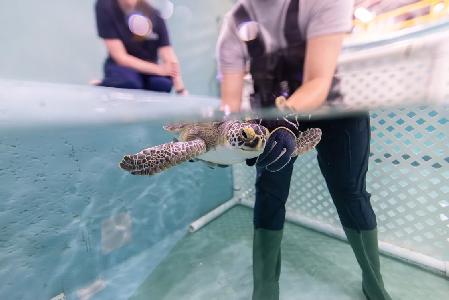
This editorial article is a part of Racial Equity in Tech Month 2022 of Technical.ly's editorial calendar. This month’s theme is underwritten by Spotify. This story was independently reported and not reviewed by Spotify before publication.
The first group of young people to participate in the University of Maryland, Baltimore’s long-term STEM program for secondary students celebrated the end of its collective journey with a celebratory graduation ceremony last month.
The 17 students represent the inaugural cohort of the university’s CURE Scholars program, a STEM enrichment initiative that follows such students from sixth grade until high school graduation. It currently works with youth from the West Baltimore schools of Green Street Academy, Franklin Square Elementary Middle School, Southwest Baltimore Charter School, with hopes to expand to KIPP Ujima Village Academy.
The program’s multi-year model and focus on young people in West Baltimore — much of which sits in the “Black butterfly,” which ethnographers use to describe predominantly Black neighborhoods that institutional racism rendered largely segregated and under-resourced — models how universities can create programs that not only address town-and-gown tensions, but also make the STEM talent pipeline more diverse.
“What we tell parents is that CURE is not an after-school program, it’s an investment in your child’s future,” Gia Grier-McGinnis, CURE’s executive director, told Technical.ly.
STEM careers have an annual mean wage of $100,900, compared with $55,260 for non-STEM occupations, according to the Occupational Employment and Wage Statistics (OEWS) report that the Bureau of Labor Statistics released in March. Such careers can lift families out of poverty and create generational wealth that is largely impossible to build in underserved neighborhoods.
Grier-McGinnis also grew up in West Baltimore and went through career exposure programs similar to CURE, including the National Aquarium’s Henry Hall program. These experiences inspired her to get two degrees in environmental science, so she knows firsthand how programs like CURE can impact students’ career trajectories.
Last month’s graduates began their CURE journeys in 2015. Youth commit to the program from 6th to 9th grade and then recommit to finish out the program in high school. At a minimum, UMB follows and supports a West Baltimorean in the program for three years. There are no GPA requirements, and eligible students simply need an interest in a STEM career.
“A lot of people would think it can’t be done to hold onto students for so many years, but our families kept recommitting year after year and now, we see some of them going off to college,” Grier-McGinnis said.
But it is difficult to keep a kid engaged for six years as outside factors creep in — especially during high school. The urge to earn money with a summer job tends to be the strongest pull away from CURE. Once a student can help support their family in the short term, they may see less value in a program like CURE that primarily impacts their future. CURE tries to contend with that by being a summer job site for the city’s summer jobs program, YouthWorks.
Grier-McGinnis said that the program, including payroll, costs a little bit under $1 million to run. There are 115 scholars in the CURE program across seven cohorts.
Some may wonder why the program starts students so young, before they have more awareness of their goals or maturity. From what Grier-McGinnis has seen, students develop interests based on exposure. She’s witnessed kids experiencing veterinary science through the program and holding onto that all through high school.
“It doesn’t take a lot to inspire them,” Grier-McGinnis said about middle-school pupils. “All they need is to see someone that looks like them doing that kind of work and then it kind of imprints. It’s not like you have to wait until they’re juniors and seniors in high school. Putting the bug in their ear early, I think, can be really impactful.”
Check out this video from the first cohort’s recent graduation ceremony:
Donte Kirby is a 2020-2022 corps member for Report for America, an initiative of The Groundtruth Project that pairs young journalists with local newsrooms. This position is supported by the Robert W. Deutsch Foundation.Join the conversation!
Find news, events, jobs and people who share your interests on Technical.ly's open community Slack

Baltimore daily roundup: An HBCU innovation champion's journey; Sen. Sanders visits Morgan State; Humane Ai review debate

Baltimore daily roundup: Medtech made in Baltimore; Sen. Sanders visits Morgan State; Humane Ai review debate

Baltimore daily roundup: The city's new esports lab; a conference in Wilmington; GBC reports $4B of economic activity


